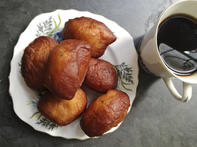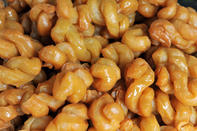Sweet, Sticky and Homely

If you're eating out and the menu offers malva pudding for dessert, don't pass up the opportunity to indulge your taste buds in a dose of seriously yummy sponge pudding. It's gooey, sweet and drenched in hot syrup. Is your mouth watering yet?
A Sweet Delicacy

South Africans who love a good dose of sugar queue up at church fetes and cake sales to buy koeksisters, a traditional Afrikaans delicacy. They’re made from plaited dough (left over right), fried in oil and then coated with a sugary syrup. If you're a koeksister virgin, get one from a home-bake store or, preferably, a small-town cake sale. The Cape Malay version of this much-loved treat is rolled in coconut.
Take On a French Classic
Whoever thought of turning the favourite fruit and legendary intoxicant of the African elephant into a cream liqueur not only had a moment of inspiration, they also invented the most popular after-dinner tipple of the - not bad for a moment of post-braai merrymaking. Whichever chef first used it for a brülée hit a winner.
Serving a brulée can be a show-stopping spectacle if you use a blowtorch to melt, not scorch the sugar on top; it all depends how much Amarula Cream you've had. The blow torch also helps to keep the elephants, away when they come looking for the fruits of their favourite trees.
Best Served Dunked
Hard as rocks, difficult to eat on their own, but definitely not suitable only for teething toddlers, rusks should be dunked into tea or coffee to be truly appreciated (just remember not to slurp the last sip in the cup). Best on a winter camping trip, dunked into coffee made with long-life milk and water boiled on a fire.
Fruit Roll
If you've never eaten a guava roll - pulped guavas mixed with sugar, dried in the sun and then rolled up you’re missing out — big time. They taste best when they've been in the bottom of your backpack for a few days and you're up in the mountains somewhere.